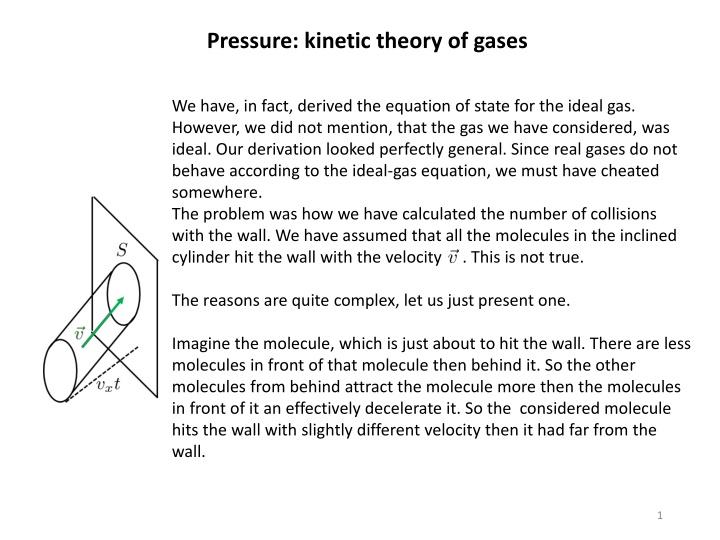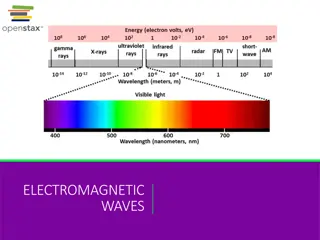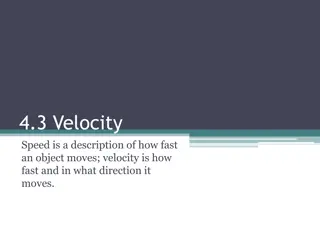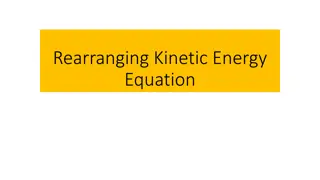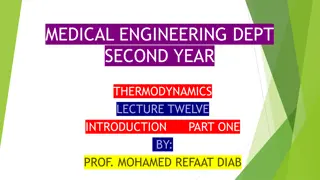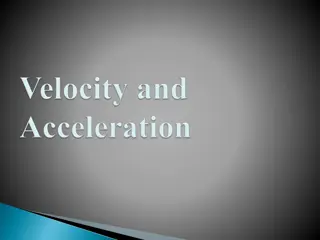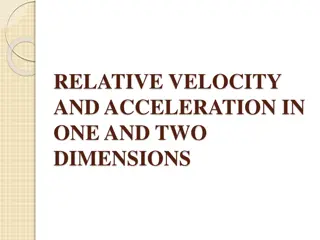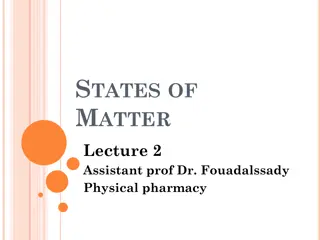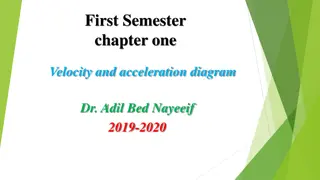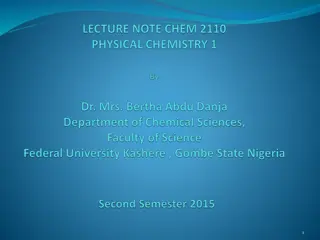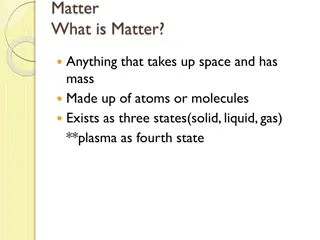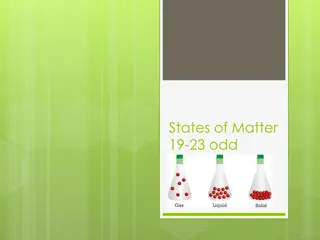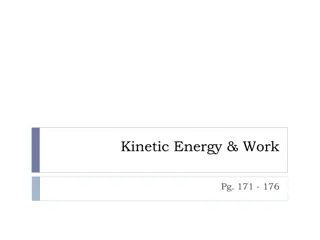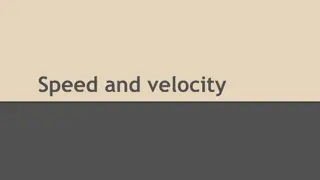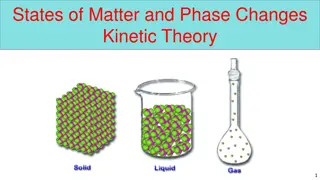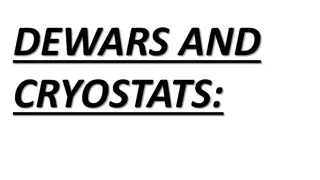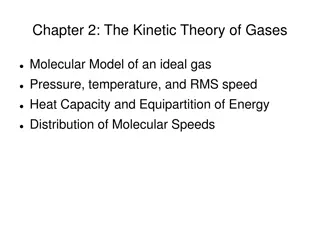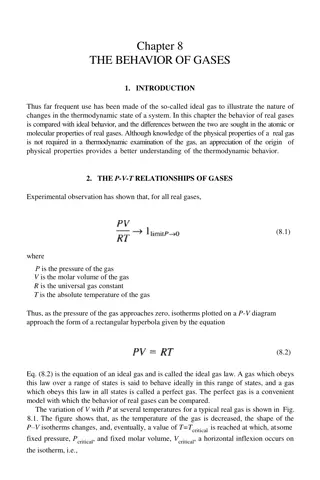Insight into Kinetic Theory of Gases and Maxwell Velocity Distribution
The discussion delves into the kinetic theory of gases, highlighting the deviations from ideal gas behavior and the derivation of the Maxwell velocity distribution. It explores the intricacies of molecule-wall collisions, Maxwell's assumptions, the Gaussian distribution, and the concept of reversible processes in gases.
Download Presentation

Please find below an Image/Link to download the presentation.
The content on the website is provided AS IS for your information and personal use only. It may not be sold, licensed, or shared on other websites without obtaining consent from the author.If you encounter any issues during the download, it is possible that the publisher has removed the file from their server.
You are allowed to download the files provided on this website for personal or commercial use, subject to the condition that they are used lawfully. All files are the property of their respective owners.
The content on the website is provided AS IS for your information and personal use only. It may not be sold, licensed, or shared on other websites without obtaining consent from the author.
E N D
Presentation Transcript
Pressure: kinetic theory of gases We have, in fact, derived the equation of state for the ideal gas. However, we did not mention, that the gas we have considered, was ideal. Our derivation looked perfectly general. Since real gases do not behave according to the ideal-gas equation, we must have cheated somewhere. The problem was how we have calculated the number of collisions with the wall. We have assumed that all the molecules in the inclined cylinder hit the wall with the velocity . This is not true. The reasons are quite complex, let us just present one. Imagine the molecule, which is just about to hit the wall. There are less molecules in front of that molecule then behind it. So the other molecules from behind attract the molecule more then the molecules in front of it an effectively decelerate it. So the considered molecule hits the wall with slightly different velocity then it had far from the wall. 1
Maxwell velocity distribution The velocity of a molecule is a random vector (random 3-dimensional continuous quantity) with probability density . The distribution was first derived by Maxwell in 1860 on heuristic grounds. Maxwell used two essential assumptions: rotational symmetry and statistical independence of the variables . Rotational invariance requires that the distribution function can depend only on rotational invariants, which can be constructed from . There is only one such variable , what means, that the probability density, which a priori is a function of three variables, can be expressed as just a function of one variable Assuming independence of the three random variables we get, that the probability density factorizes Taking these two assumptions together we get Without trying to do some fancy mathematical reasoning we can simply ask what function makes product from a sum, with the obvious answer the exponential . So the obvious hypothesis is with ?,? some arbitrary (for the moment) parameters. 2
Maxwell velocity distribution We arrived at a Gaussian distribution. The kinetic theory of pressure has lead to the relation The Gaussian probability distribution must be consistent with this, so (together with the requirement of a proper normalization) the distribution is uniquely given as Let us stress that the requirement of spherical symmetry is more-or-less unavoidable. The requirement of statistical independence of the variables is, on the other hand, not forced by any general physics arguments. It was a clever hypothesis justified a posteriori by agreement of many of its consequences with experiment. We add a note that the Maxwell distribution can be seen as a direct consequence of canonical distribution we shall meet later on, so canonicity leads directly to independence of directions. For experts we add a note that a careful analysis of physical kinetics (Boltzmann kinetic equation and its collision term in particular) leads to independence of directions directly. 3
Reversible processes in gas Consider an equilibrium state (macrostate) of gas. By definition it is a macroscopically static situation, the values of macroscopic physical quantities do not change with time. Now consider some action of an outside agent changing some external parameters. After such a change the gas state is no more in the equilibrium state, because it is not in equilibrium with outer conditions. So the macrostate starts to change and after some relaxation time it becomes consistent with the outer conditions and becomes a new equilibrium state. However when the action of the outer agent is such, that the outer conditions change by only a small (infinitesimal) amount, then the relaxation time to reach a new equilibrium is very (infinitesimally) small and we would see rather contradictory situation. The state of the system will be constantly in the equilibrium state but still it would be changing all the time. This seeming contradiction is in fact the same contradiction as recognized by ancient philosophers like Zeno of Elea, who felt the contradiction between the current position and the current velocity . So we have arrived at the notion of equilibrium process or reversible process. It is a process controlled by an outer agent in such a way that the process can be changed to a reversed one by an infinitesimal change of the agent s action. 4
Equilibrium states of gas Experimental practice shows, that for a fixed amount of gas (mass, number of molecules) the equilibrium states are uniquely determined by just two macroscopic parameters. Most often we choose two of the three common variables volume pressure temperature Pressure is measured by pressure gauge, volume can be calculated from dimensions of the container , and temperature is measured by a thermometer. If we want to observe macrostates at different volumes, we use a piston instead of a fixed wall of a container 5
PV diagram Since the space of equilibrium macrostates of gas is two-dimensional, we can visualize them in a plane diagram, most often by a ?? diagram. A point in a ?? plane represents an equilibrium state. Do take into account that only equilibrium states can be fully visualized on a ?? diagram. The non- equilibrium states have more degrees of freedom. To specify them we have to add some variables describing the difference from equilibrium . For example we shall not have just one value of pressure if the gas is not yet homogenous. Places with higher density of molecules would have higher pressure: so two pressure gauges introduced to different points in the gas would show different values of pressure. So only reversible processes can be fully visualized as lines in a ?? diagram 6
Reversible processes in gas experimental setup If we want to study reversible processes in gas, we need to have control over two parameters, let us say ?,?. Suppose we want to perform the process visualized in the following figure (left). We can consider the continuous reversible process as if it was a discrete process through a sequence of equilibrium states (right figure). We need an experimental setup to perform such a step by step reversible process. We hire two dwarfs (external agents) as presented in the next figure 7
Reversible processes in gas experimental setup The first dwarf (piston-pusher) can set any ? value (in the vicinity of the current value) by moving carefully the piston by small amount. He has to act by a proper force on the piston: a bit higher then corresponding to the gas pressure (if he wants to decrease ?) or a bit lower then corresponding to the gas pressure (if he wants to increase ?). The second dwarf (boiler attendant) can set any pressure ? (in the vicinity of the current value) indirectly by increasing or decreasing the current temperature of the gas. To control temperature in a reversible manner is a tricky task. Here it is how it can be done. The boiler attendant controls roughly the boiler water temperature (by manipulating the valves with hot and cold water) in an external boiler which serves as a heat exchanger. The boiler is in thermal contact with the gas through an interface with low coefficient of heat transfer. If the boiler water is a bit hotter then the gas, energy slowly flows from the boiler to the gas thus increasing its temperature. If the boiler is colder then the gas, energy slowly flows from the gas into the boiler thus decreasing slowly the gas temperature. The energy exchange between the boiler and the gas is an irreversible process (the boiler and the gas are not in the state of mutual equilibrium), but the gas remains in internal equilibribrium because the energy transfer is slow. 8
